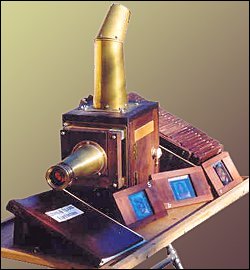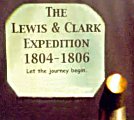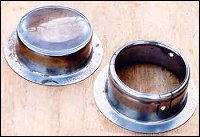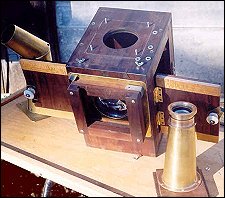|
Gale Wollenberg a modern magic lantern builder |
Gale Wollenberg Topeka, Kansas, U.S.A.  It all started with a comic book Gale read as a boy. The book told the story about a magician who used a magic lantern to project a ghost. Now Wollenberg, a magician by avocation, a tool maker by trade, is seen here re-creating these fascinating devices in his Topeka garage workshop. 
|
Back in 1998 I was "surfing the net" and was putting all kinds of key words into my
favourite search engine. I was searching for 'magic' or 'magician' web sites and
then also some addresses came onto the screen
telling of magic lantern sites. Since my earliest recollections of where I had seen reference to a magic lantern happened to be in a comic book, I decided to search out those magic lantern sites. Three sites really impressed me; one of them was 'de Luikerwaal'. I soon found the British Magic Lantern Society web site, then found more lantern web sites and started e-mailing the site owners with all kinds of questions about magic lanterns. Soon I found myself wanting to own a magic lantern and since my trade is tool and die work and general machine work, the least expensive way to become owner of a magic lantern was to build one from scratch.  Before too long I had
my first one built and planned immediately to build another. This building phase started in
1999. Soon I started making slides and doing shows. I continued building more magic lantern
replicas: a Ross bi-unial, a pair of L.J. Marcys and then a third L.J. Marcy, a number of motion slides and chromotropes,
a pair of Japanese "furos" for doing the minwa-za shows. Before too long I had
my first one built and planned immediately to build another. This building phase started in
1999. Soon I started making slides and doing shows. I continued building more magic lantern
replicas: a Ross bi-unial, a pair of L.J. Marcys and then a third L.J. Marcy, a number of motion slides and chromotropes,
a pair of Japanese "furos" for doing the minwa-za shows.The projectors I've built are 95 percent made of recycled materials. The wood comes from old oak crates and the brass from a salvage yard. The lenses also are enjoying a second career: some come from scrapped copy machines. Once a lantern was complete, I had to trim the lens tubes to get the double image to focus at 40 feet, which is a good length for shows in front of large groups. I regularly had to reinvent the wheel at that time and  had to
tinker with things to make it come out right. had to
tinker with things to make it come out right.Finally I decided to build a single form of a German made side by side bi-unial, the original of which was built around 1850. The reason for building this type of replica was so that I would have a lantern that represented the time period of 1800 to 1850. This would be the one for me to use for showing the Lewis and Clark expedition slides for the local schools during the bi-centennial years of this famous journey of discovery. I even made the slides myself. I'm always looking for well-illustrated books published before 1900. Publications that old would be no longer protected by copyrights. I photocopy the illustrations from the old books. Then I colour the image and photocopy it to a transparency, reducing the image to the correct size for a slide, 3 1/4 inches square. Since they're basically etchings, they transfer really well to transparency. I also made my own slide version of Charles Dickens' "A Christmas Carol" in this way. |
 The Lewis and Clark expedition (1804–06): first U.S. overland expedition to the Pacific coast and back. It was conducted under the leadership of Captain Meriwether Lewis and Lieutenant William Clark, who brought back diaries and maps that contained a lot of valuable information. |
The lantern was completed in about two weeks actual time but was delayed because at first a friend who has a re-saw mill was not able to schedule my black walnut for sawing between his commercial jobs. Once that was done,  another
friend who has a planing mill planed the lumber to the proper thickness of 5/8". Then it was a matter of sawing
everything to size and cutting the dovetail joints for the corners which of course were all cut by hand. Then I made
the door frames which are of the overlapped corner joint type and glued. These frames are then planed and sanded
to fit the lantern box and both are held fast with wood screws all around. another
friend who has a planing mill planed the lumber to the proper thickness of 5/8". Then it was a matter of sawing
everything to size and cutting the dovetail joints for the corners which of course were all cut by hand. Then I made
the door frames which are of the overlapped corner joint type and glued. These frames are then planed and sanded
to fit the lantern box and both are held fast with wood screws all around.
Then the condensor lens hole was marked out
and the 3 inch hole was cut out with a hole saw and a special tool was made to counter-bore this hole to fit
the condensor lens tube. |
Furo: It is said that the Dutch brought the magic lantern to Japan in the 17th century.The Japanese then made their own version and called it 'furo', after a bath-tub of similar shape. These simple wooden magic lanterns were used in Japanese lantern shows from 1803 to c. 1900. Each furo lantern was hand-held during the show by a separate projectionist, and projected the image of a single character or piece of scenery. The wooden construction protected the lanternist from the heat of the candle or oil lamp. Special lights effects were created by means of a piece of cloth attached like a curtain on top of the square lens tube. A curtain also was used on the back rather than a door, for easy access to the kerosene lamp. |
 IT WORKS!!!! |
|
|
©1997-2021
'de Luikerwaal' All rights reserved. Last update: 15-05-2021. |
|
 This is an example of what can be used to house the condensor lenses.
I used a stainless steel flange from a sink grinder. Since the older lanterns used the round slides that were
wood framed (3 inch diameter glass) the condensors only need to be that diameter. With that being the case,
a person can use the condensor lenses from a junk big screen television. The outer lenses are usually plastic but the
centre lens is nearly plano/convex and usually a little over 3 inches in diameter.
This is an example of what can be used to house the condensor lenses.
I used a stainless steel flange from a sink grinder. Since the older lanterns used the round slides that were
wood framed (3 inch diameter glass) the condensors only need to be that diameter. With that being the case,
a person can use the condensor lenses from a junk big screen television. The outer lenses are usually plastic but the
centre lens is nearly plano/convex and usually a little over 3 inches in diameter. the front part of the wood frame slide guide. Then came the making of the
tapered brass objective lens tube and the two piece tapered brass chimney.
the front part of the wood frame slide guide. Then came the making of the
tapered brass objective lens tube and the two piece tapered brass chimney.